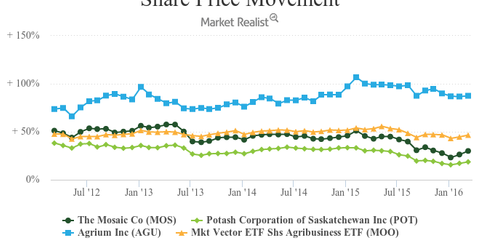How Phosphate Fertilizer Prices Are Changing Trends
In the 2010–2011 planting season, phosphate fertilizers accounted for about 23% of total NPK fertilizers consumed globally.
March 10 2016, Published 10:02 a.m. ET

Phosphate fertilizers
Phosphate fertilizers are the second most important fertilizers out of the three NPK[1. NPK stands for nitrogen, phosphate, and potash] macronutrients required for crops. In the 2010–2011 planting season, phosphate fertilizers accounted for about 23% of total NPK fertilizers consumed globally, according to the International Fertilizer Industry Association.
[marketrealist-chart id=1122834]
YTD performance
YTD (year-to-date), Mosaic Company (MOS), PotashCorp (POT), and Israel Chemicals (ICL) have turned positive, returning 7.9%, 10.3%, and 10.8%, respectively. Agrium (AGU), on the other hand, has returned -1%. Some of these companies are held by the VanEck Vectors Agribusiness ETF (MOO), which invests about 30% of its portfolio in agricultural chemicals.
Farmers around the world use different types of phosphate fertilizers, depending upon the type of soil and the crops to be planted. The most common phosphate fertilizer utilizes MAP (monoammonium phosphate), DAP (diammonium phosphate), and TSP (triple superphosphate). According to the International Plant Nutrition Institute, TSP is less popular due to its lower total nutrient content compared to ammonium phosphates.
Series overview
In this weekly price update series, we’ll review the price trends for key phosphate fertilizers such as DAP and MAP. We’ll also look at the factors that impact the prices of these phosphate fertilizers. Looking at these key metrics may help to explain why the above companies have turned positive YTD.
